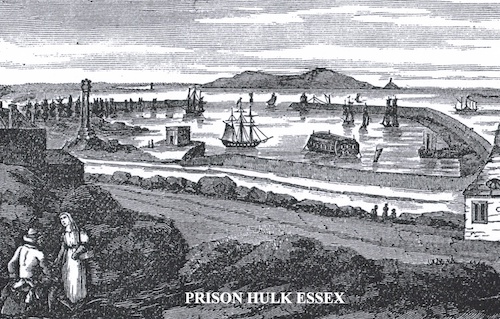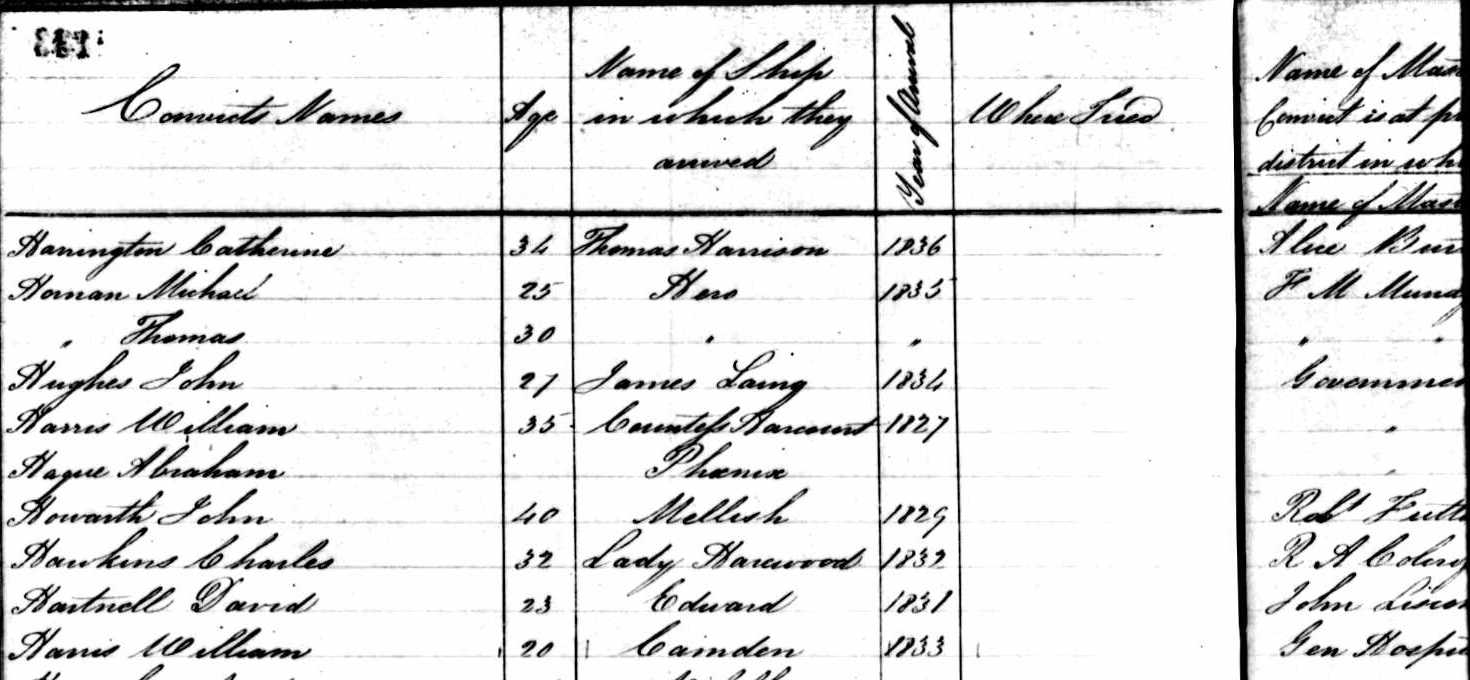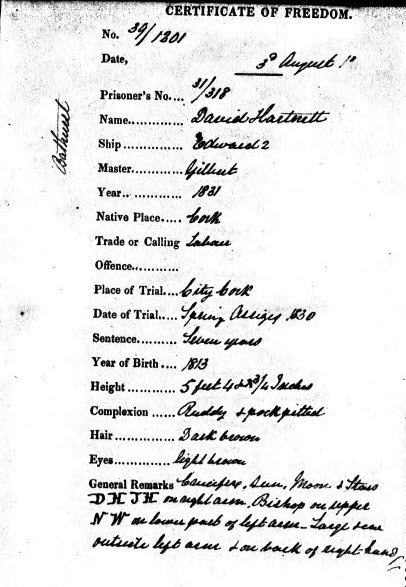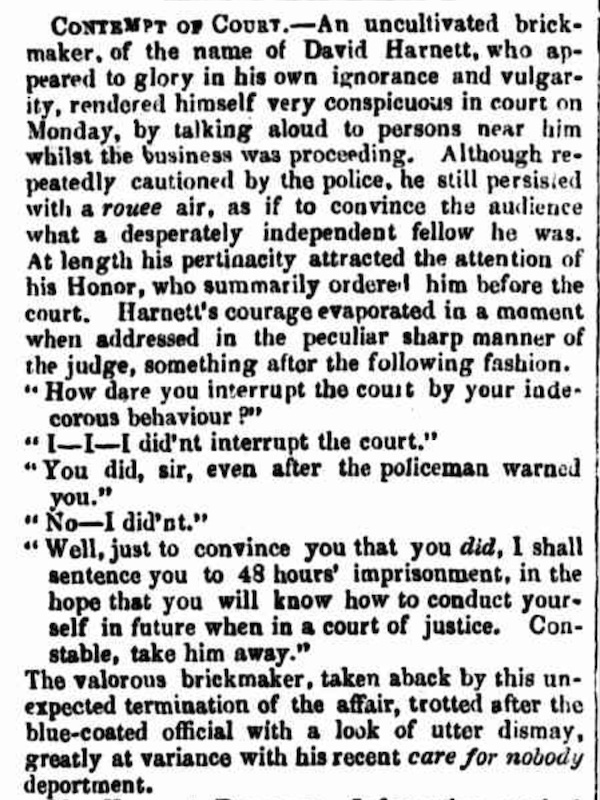1813:
David Hartnett was born in Cork, Ireland to John HARTNETT and Mary Anne COLLINS.
1830:
He was charged with vagrancy at the Cork Spring Assizes on March 30. Six others were also charged. He was sentenced to 7 years transportation. At the time his occupation was listed as errand boy and he was 17 years old. He had a former conviction simply stated as “second 3 months” (I am assuming that this means the first conviction was for 3 months).
After sentencing he was sent to the hulk, Essex. The Essex was used as a floating prison and as a detention centre for convicts awaiting transportation to Australia, many of whom were re-routed to Cork by sea before heading to the Colony. (Guardships at Kingston by Cormac F. Lowth)
Most hulks used as long term gaols were made by stripping the ships superstructure and replacing it with a two or three level dormitory style building with kitchen, mess hall, ablution block and chapel.
Essex was formerly USS Essex, a very strongly built thirty-two gun frigate, built in 1799 in Salem, Massachusetts. Essex was incorporated into the Royal Navy and became a convict hulk at Kingstown in January 1823. The ship that accompanied Essex to Ireland as she went to be hulked was HMS Surprise, which served briefly at Kingstown before becoming a hulk at Cork.
While on the Essex Hulk a number of the prisoners tried to burn it down.
“On Monday last, some of the convicts on board the Essex hulk, stationed at Kingston, near Dublin, set fire to that vessel in three places, close to the water. The flames were fortunately suppressed, and all on board, being upwards of three hundred prisoners, were transmitted to the Hercules convict ship which had only arrived in the harbour the preceding Saturday to take to their destination.”
According to the Ship’s surgeon on the Edward(2), the ship that transported David Hartnett to Australia, “some of the most evil disposed aboard the Essex” had attempted to burn the hulk. Most of those responsible were sent on board the Hercules for New S. Wales. The rest were sent with those remaining to the Surprise Hulk in Cork Cove. From there 121 boarded the Edward. Despite the attempt to burn down the Essex failed, they tried three times to commit the same offence to the Surprise. Those convicts innocently caught up in the mutinous group became very depressed with the fear of being blamed for the fires.
David Hartnett was amongst those transferred to the hulk Surprise (which was in Cobh Harbour, Co.Cork)
In the 1830s, a report written by an English Inspector of Prisons, Captain W J Williams said of conditions on the Surprise:
“The hulks at Kingstown and Cork are…arranged upon the very worst form of prison discipline…the upper deck is part fitted as a hospital…; the lower deck as a sleeping room: the plan strikes one as precisely that which would be adopted for securing and lodging wild beasts; … they pass the day, lounging in idleness or basking in the sunshine: … at close of day they are mustered…into their sleeping room: but no one dares to venture into the prison”
From the Surprise he was transferred to the convict ship, Edward (2). The Edward sailed for Australia on August 23 1830.
[Note: reel SR Reel 2420 in the archives p. 417 2/8253 Edward (2) 183 – 1List of convicts embarked; Return of free convicts who died during the voyage; Account of cash belonging to convicts in the custody of the surgeon; Receipts for prisoners received on board; and Papers re military prisoners]
THE RIBBON BOYS
On November 2nd 1830, ten members of the Ribbon Boys were hanged in Bathurst for their crimes. They included five of the convicts assigned to John Liscombe of Bathurst, including Ralph Entwhistle William Gahan. Another two had died of wounds before reaching Bathurst. This was the first and largest public hanging in Bathurst. The site of the hanging is now marked by a lane in Bathurst known as “Ribbon Gang Lane”.
DAVID HARTNETT ARRIVES IN AUSTRALIA
1831:
David Hartnett arrived in Sydney on February 22 on the Edward II, 3 months after the Ribbon Gang hangings. It is probable that Liscombe was looking for extra labourers to replace those hanged. David Hartnett was assigned to John Liscombe of Bathurst. in February 1831.
David was Roman Catholic and could neither read nor write. He was 18 years old on arrival and single, 5ft 4¾ inches, “ruddy, pock-pitted and freckled” with dark brown hair and light brown eyes. He had a number of markings:
- Crucifixion, sun moon and stars, DHJH on his right arm
[The popularity of the sun, moon and stars might be understood as a reference to eternal verities which again, in combination with initials, might be a statement of durable affection.] - Bishop on upper left arm, NW on lower left arm
[ Perhaps the Bishop represents Saint Patrick, the primary patron saint of the island and known as the “Apostle of Ireland”.] - Large scar on the outside of the left arm
- Large scar on back of the right hand
JOHN LISCOMBE of Bathurst.
John Liscombe was Bathurst’s first stock and station agent. In 1829 he owned ‘Stowford’ about twelve miles south-west of Bathurst in Fitzgerald Valley. He had come free to the colony in 1825 and held the position of Police Clerk at Bathurst in addition to his grazing interests. [“A History of Bathurst” Theo Barker ] When the Bathurst Post Office opened in March, 1828, Mr. A. Macleod was temporarily employed until the Clerk to the Bench of Magistrates (1828-38), Mr. John Liscombe, took over. He was also the first coroner of Bathurst during this time. By 1840 John LISCOMBE was the owner of Mount Tamar.
What was Bathurst like when he arrived in 1831?
“In 1830 there were no planned streets and Bathurst consisted of buildings dotted about the landscape. The site for the scaffold was chosen because it was close to the gaol and court house but these were not the structures that exist today or even the ones that preceded them. In 1830 the gaol stood in what is now lower William Street but the location of the court house at that time is unknown.”
– [Theo Barker – A History of Bathurst – 1992]Bathurst consisted of six brick cottages and two mud houses, occupied by the military, police and government facials, the hospital and the convict establishment with its lumber yard.”
– [Bathurst in the 1930s by an anonymous widow in the Bathurst Times, 1 Dec 1901]
1934:
On November 18, while DAVID HARTNETT was bonded, he was detained on the Hulk Phoenix in what is now Lavender Bay, as he was called as a witness. He was returned to Parramatta when he was no longer needed.
“Between 1825 and 1837 the prison hulk Phoenix was used to house an overflow of felons from Sydney Gaol. It was moored in Sydney Harbour at Lavender Bay – known then as Hulk or Phoenix Bay – as a sobering symbol of the ‘strength and terror’ of the colony’s police, according to Governor Brisbane. It housed up to 260 prisoners at a time, including those awaiting trial, convict witnesses giving evidence, ailing convicts waiting for a ship to Port Macquarie Invalid Station, and those under colonial sentence of re-transportation.” – [Hulks in Lavender Bay]
“Commonly used in England to supplement prison accommodation, hulks in Australia’s prison history are not so well known. The Pheonix was the only prison hulk ever to operate on the Australian mainland. It anchored off the shores of Lavender Bay for eleven years from 1826.
Hulks did not seem a likely solution to the overcrowding in Sydney’s prisons at the beginning of last century. Any ship which had been condemned overseas would never make the trip. But just as prison accommodation was reaching crisis point, the Phoenix ran aground on the Sow & Pigs Reef just inside the harbour entrance.
There she remained stuck for 24 hours. The survey found her damaged beyond repair and thus she was to finish her days as home to three categories of prisoner, all of them male :
- those en route to penal settlements elsewhere in the colony,
- those in a “weakly” state and
- witnesses waiting to testify in criminal cases.
In the early hours of June 1837, she started taking water. Although sinking was avoided it spelt the beginning of the end and the following year the Phoenix was decommissioned and sold for scrap.”
– [http://bonesinthebelfry.com/smart/Phoenix%20Hulk.html]
1837: Muster
David Hartnett appears in the 1837 muster as still being assigned to John Liscombe of Bathurst. By now he was 23.
1839:
David Hartnett was granted his Certificate of Freedom at Bathurst on August 3 (longer than 7 years).
1849:
Gold was found in conjunction with Copper on Thomas Iceley MLC, property “Coombing” near Carcoar.
1851:
On August 18 at 2pm David (shown in the records as Harnotts) was admitted to Bathurst Gaol for a confinement of 48 hours. He was there for “contempt of court” and was released on August 20. His occupation was brickmaker but listed at the time as labourer. (prison entry no: 187) His contempt of court occurred at the trial of Richard Lees who was convicted of horse stealing from William Devine at Narrambla. (SMH Friday 22 August 1851) Richard Lees was indicted for stealing at Narrambla, on the 22nd July, one mare of the value of ten pounds, the property of William Devine.
It appeared that Devine was gold digging at Ophir, in the month of July, and had entrusted the mare to the prisoner to take to Mr. Templar’s accommodation paddock, at Narrambla. This trust the prisoner performed, but gave in the mare in his own name instead of that of Devine. The prisoner then went on to Orange, where he spent some days drinking, and during which time he sold the mare to a person named Fox, for four pounds. Eight or nine days after the mare was entrusted to the prisoner, Devine, from information he had received, went to Orange, where he found the mare, which was claimed by Fox; Devine took possession of the mare, and caused Lees to be apprehended.
The prisoner stated in his defence, that he had purchased the mare from Devine, for the sum of three pounds ten shillings. Verdict, guilty. Sentence, five years hard labour on the roads or other public works of the colony.
His Honor remarked that it would be useful for parties entrusting property to drovers or carriers, to know, that formerly there was a difficulty in convicting such persons of larceny if they made away with the property so entrusted to them, but that by the Act of Council, 14 Vict., -No. 6, this difficulty was removed, provided the party so entrusting such property, made a written agreement with the person conveying it, to the effect that such person conveyed such property for hire or re- ward, even if such hire or reward was ever so small in amount.
1861:
David married MARY McKENNA on July 15 in Bathurst at the Church of St Michael and John. David was 40 and Mary Ann was 25. Bartholomew White and Mary Maloney witnessed the marriage. They were married by Dean John Grant DD. 3 months after the church was opened. It is said the Dean “was the most respected and influential man in The West”.
She was the daughter of Richard McKENNA and Anne CONLON and was born in Ireland.
When they married they were both living in Bathurst -David was a brickmaker and Mary was a servant. She had arrived 4 years earlier, in 1857, on the John Bunyan which arrived in Sydney on October 20. She is listed as 24 years old (which conflicts with her age at marriage) and had come from Dundalk in County Louth, Ireland, where her parents were still living. Like David she could neither read nor write and was Roman Catholic. She was in good health and had paid 10/- for her assisted passage although she had no relatives here at the time.
In 1857, the year Mary arrived, the foundation stone of St. Michael and St. John’s Cathedral in Bathurst was blessed by the Archbishop of Sydney, Dr John Polding, with the blessing and opening in April 1861.
1862:
Daughter Mary Teresa was born in Howick Street on June 30.
David was still a brickmaker at the time.
THE HARTNETTS IN CARCOAR
1863:
John O’Meally and Johnny Gilbert, members of Ben Hall’s bushranging gang, attempted Australia’s first daylight bank robbery in Carcoar. Casually fronting the teller of the old Commercial Bank Gilbert demanded all of the money in the bank. But the clerk produced a pistol and took a shot at them and the pair fled.
The Hartnetts were in the Carcoar district from at least 1864 to 1870 as 3 children were born there. (Their daughter Mary married there in 1882.)
1864:
Their first son Michael was born on January 26 in the district of Carcoar. The Hartnetts had moved to the area sometime in the past 18 months between July 1862 and the start of 1864.
1865:
Another son, (John) Thomas was born on 13 January in the Carcoar district, 2 weeks before his brother Michael’s first birthday. (In his father’s death certificate his age was such that he was born around 1867. I can’t find his birth/death in the BDMs).
1869:
Daughter Louisa was born. [This date is taken from her father’s death certificate so could be approximate. Not found in the BDMs].
1870:
The Hartnetts were still in the Carcoar area when their daughter Catherine was born on August 8. Catherine was the name on her birth certificate, but her name was changed to Louisa (ANN) for baptism. There wasn’t another girl in the family called Catherine. She also has several versions of her middle name – Ada, Annie. The most probable is Ann, because it is a name that appears in her future family.
1880:
A Thomas Hartnett married Mary Gammage in Yass. [ no proof yet that this is our Thomas but this would have made him a 15 yr old husband!]
1882:
When David was 69 his daughter, Mary Teresa, married William LOUGH in Carcoar. Their marriage took place on August 7 and it was witnessed by Ann E Links and John Links the Carcoar storekeeper/baker. Mary was living in Carcoar at the time but it is not yet known whether the rest of the Hartnett family was still there. If they were, they would have been in the area for almost 20 years.
1885:
Catherine Hartnett married Walter JONES in the Tumut District [ no proof yet that this is our Catherine but this would make her a 15 yr old bride]
1886:
Michael JJ HARTNETT married a Sarah A. Whitworth in Sydney. [It is not yet established if these were our Michael].
1895:
David HARTNETT was admitted to the Macquarie St Asylum at Parramatta on January 1.
[Macquarie Street Asylum(1884-1913): Although functioning primarily as an asylum for infirm and destitute men from 1884, wards for infectious conditions were still maintained and used for cases refused admission to Sydney Hospital, the Macquarie Street Asylum reputed to be “one Hospital whose doors are open to cases of all kinds of disease.” The Government Asylums generally included medical wards, and Macquarie Street became the centre for treatment of serious eye conditions, with 342 ophthalmic cases treated at Macquarie Street in 1893. – State Records Archives]
1897:
He died at the age of 84 at 4.15am on April 23 at the Macquarie Street Asylum in Parramatta. His death certificate erroneously says he was 75, 9 years younger than he was.
He was buried at Rookwood the next day in a common grave in the old Catholic Section (1897; C590; Section P, Joseph Wing). The site is now below a busy Homebush street.
His death certificate also states he had been in the colony for 53 years when in fact he had arrived as a convict in 1831 (thus about 66 yrs). It is worth checking if he left and returned around 1843-4 after he had received his freedom.
1900:
Daughter Louisa (Catherine) married John James Lyle in the Roman Catholic Church in Dubbo on October 10. John was a carpenter who was born in Sofala. Sadly Louisa died in Dubbo 12 years later on 12 December, 1912, leaving John to care for their 8 children, the youngest under 2.
1902:
David Hartnett’s wife Mary Ann McKenna is said to have died in the Ryde area [Claire McLean]. This still needs checking as Louisa’s marriage certificate says she had died when Louisa married in 1900.
NOTE: He appears on various records as: William Harnett, David Hartnett, Harden, Harnotts, Hartnell.



